Hitches and Towing 101
| CHAPTER CONTENTS | |
| 1. Introduction to Towing | 7. Brake Controls |
| 2. Towing Components | 8. Hitch Installation |
| 3. Types of Hitches | 9. Hooking Up |
| 4. Determining Tow Capacity | 10. Tow Bars/Dinghy Towing |
| 5. Selecting Your Hitch | 11. Towing Safety |
| 6. Wiring/Electrical | 12. Preparing Your Tow Vehicle |
Chapter 5
- Selecting Your Hitch 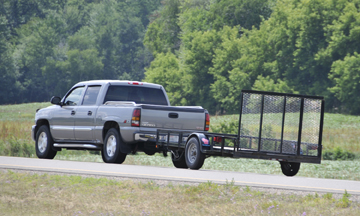
When
you know your vehicle's towing capacity and your total trailer weight, you have
the information you need to select a hitch. As you shop for a hitch, bear in
mind that it's good to have excess capacity. Sometimes your towing needs will
increase - perhaps you'll buy a larger boat or camper - and you don't want to
have to purchase a heavier hitch later on. You can always tow a lighter trailer
with a heavier hitch, with the exception of a weight distribution
hitch. Because a weight distribution hitch is essentially a
spring, using a higher rated spring bar then necessary will create a stiff ride
and could cause problems.
Figure 5-1 shows a table of common trailer
types and tow vehicles. Find your trailer at the top of the figure, then find
your tow vehicle style on the left side. Follow the trailer column and the tow
vehicle row to find the likely hitch class you will need. 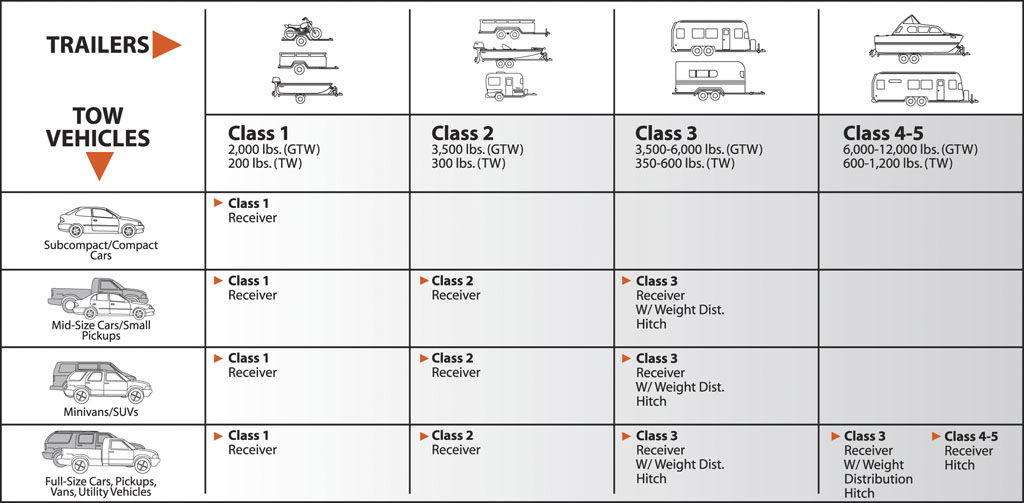
(click image to
enlarge)
Figure 5-1: Matching Trailer, Tow Vehicle, and Hitch Class
If your trailer is a fifth wheel or gooseneck design, then you already
know you need that style of hitch, and all that remains is to select a hitch
with an appropriate weight rating for your trailer.
The information in
Figure 5-1 is handy, but make sure you check to make sure your particular
trailer does not exceed the weight listed. You may have to adjust the
information in this figure if your trailer is heavier than
expected.
Shopping for a Hitch
When you know what
hitch class you need, talk to your trailer hitch dealer about the designs that
are available. Your dealer may have some recommendations for your particular
vehicle. Some hitches are made to be unobtrusive and hide under your vehicle's
bumper, while others are designed to be more prominently placed or can not be
hidden due to the vehicle's undercladding. You have many options in hitch
style, quality, finish and in some cases even color, so investigate and invest
in the trailer hitch that best meets all your functional and aesthetic
needs.
Armed with the right basic tools, the manufacturer's
installation instructions, and a little patience, most hitches can be installed
by car and truck owners with little mechanical expertise. Some hitches
may require specialized installation techniques, and you should know what
the installation requirements will be before you make a purchace. See Chapter 8
for more information on hitch
installation tips and techniques.
If your vehicle came with a hitch
installed by the manufacturer, check to make sure that the class of hitch on
your vehicle matches your needs. If not, you can usually find a good aftermarket
hitch with increased capacities - but again, never exceed the
manufacturer's rating capacity for your tow vehicle. See Chapter 4 for
help on determining
your vehicle's towing capacity.
Choosing a Ball
Mount
When you have selected a hitch, you also need to select
the correct ball mount. The right
ball mount has a shaft sized to match the receiver tube, and raises or lowers
the hitch ball to ensure that your tow vehicle and trailer each remain level as
you travel.
Consider the picture shown in Figure 5-2. The receiver tube
on your vehicle's hitch (A) may be higher than the trailer coupler (B) when the
trailer is sitting level on level ground. When you tow, you want your trailer to
be level so that your load is less likely to shift. If your trailer has 2 or
more axles, you want the trailer level to distribute its weight equally among
its axles.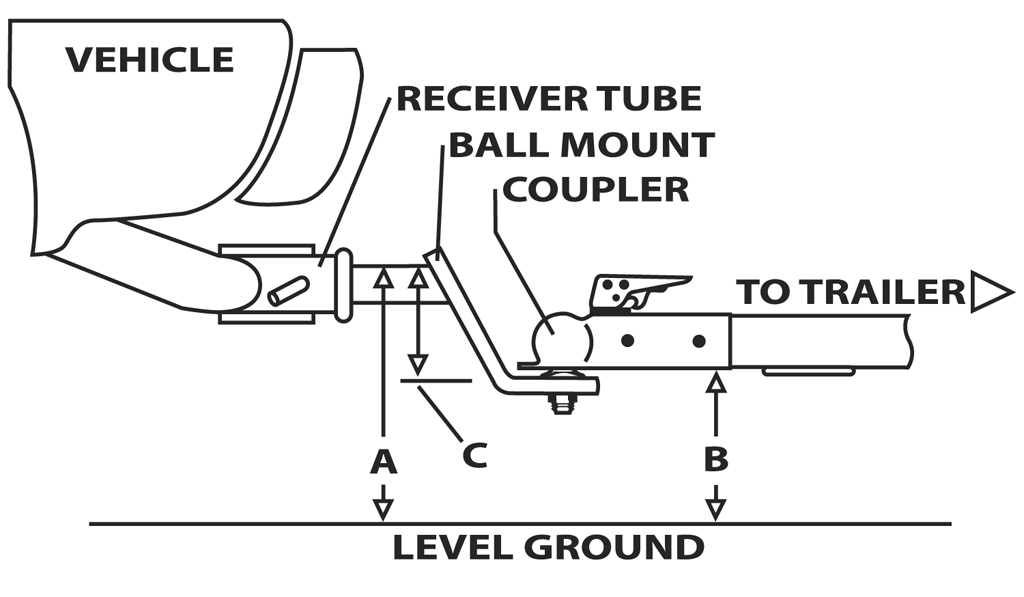
Figure
5-2: Leveling a Towing Rig
Because a given receiver is very
unlikely to be at the same height as a trailer tongue, ball mounts are made with
"drop." In Figure 5-2, the drop is indicated by measurement C. That is, you can
buy a ball mount in a variety of designs that drop the actual towing ball enough
for your particular trailer to ride level. Ball mounts designed for both "drop"
and "rise" are also known as "reversible" ball mounts.
Your trailer
dealer can help you choose a ball mount with the correct amount of drop or rise.
In some cases, you may need to turn a ball mount over to raise the ball (called
"rise") if you have a low hitch receiver and a tall trailer. Be aware that you
can also adjust the drop or the rise by selecting a ball with a longer or
shorter neck.
Setting Up a Weight Distributing
Hitch
If your trailer weighs more than 3500 pounds, you should
invest in a weight distributing hitch. If you adjust the stress on the spring
bars so that your vehicle remains level, there's no harm in using the weight
distributing hitch when your trailer is unloaded. But it's often convenient to
buy a weight carrying ball mount for those times you're pulling your trailer
unloaded, and a weight distributing hitch for pulling your loaded trailer. Keep
in mind that if there is a big difference between a loaded and unloaded trailer,
the ride may be too stiff for the trailer, resulting in some
bounce.
Consult your trailer dealer for the best style of weight
distributing hitch, and for hands-on instruction in hooking up and adjusting
your hitch. When you look at a weight distributing hitch, you'll note that the
ball mount portion is not mounted square to the shank that fits into the
receiver. The ball mount is shimmed with washers, and the tilt of the ball mount
works with the leverage of the spring bars to set the amount of weight
transferred to both the front axle of the tow vehicle and the rear axle of the
trailer.
Your trailer dealer will have experience in adjusting the tilt
to meet your needs. Once set, you will not need to re-set the tilt or the height
of the ball mount unless you make major changes in your trailer weight or your
tow vehicle's ride height. But it is a good idea to have a professional adjust
your weight distributing hitch for you.
Sway
Control

One of the most unnerving things that can happen when you're towing is when the trailer starts to "waggle" behind you. This is usually an issue with large trailers that catch the wind - or the air blast when you're being passed by an 18-wheeler. This can also frequently occur when driving at faster speeds - you may need to slow down. Sway control devices help reduce the lateral movements of the trailer and keep it in place behind your tow vehicle.
A sway control is simply a "brake pad" that uses friction to resist trailer sway once it has begun and keeps the trailer and tow vehicle stable. The sway control mounts to the trailer frame on the tongue and also to your hitch on the tow vehicle. An entire sway control kit is generally available for less than $100, and can really increase your peace of mind when towing.
The sway control works best when you combine it with a weight distribution
hitch on a Class 3 or higher rated hitch. A sway control should not be necessary
with a Class 1 or 2 hitch, and will not work with any trailer with surge
brakes.
Heavy Duty Towing - Selecting the Right
Connection
Many heavy duty trailers today are designed to tow with the connection point in the bed of a 3/4 -ton or 1-ton pickup truck. These hitches come in two designs: fifth wheel and gooseneck.
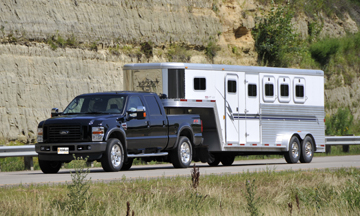
The decision about equipment is likely to be easy - the trailer you plan to tow will be either a fifth-wheel or gooseneck design. Fifth wheel hitches are popular with travel trailers and car & toy haulers, and can handle up to 30,000 pounds and up to 5,000 pounds of pin weight (tongue weight), depending on the design of the hitch, and the rating by the manufacturer.
Similarly, a Gooseneck hitch design can tow up to about 30,000 pounds with 6,000 pounds of tongue weight, depending on the design of the hitch. Some designs can be folded down or quickly removed to allow full access to the truck bed when the trailer is not hooked up, and these tend to support lower maximum weights. Fixed designs support more trailer and tongue weight. Gooseneck hitches are popular for livestock trailers, car & toy haulers, and industrial/commercial trailers.
In general, fifth wheels are used for recreational vehicles, and goosenecks are used for working trailers, such as a horse trailer. As you shop for a trailer to meet your needs, you'll find that the hitch design is likely to be consistent across all your options.
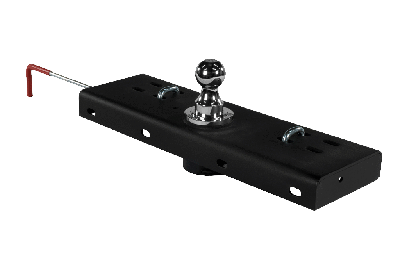 When
it comes to selecting the hitch components for your vehicle, however, you
need to follow the same procedure you use for selecting any other hitch. Match
the weight of the fully loaded trailer to the capabilities of the hitch design,
and leave yourself some margin of safety in the capability of the hitch and your
tow vehicle. For example, a fold-down gooseneck hitch may be convenient, but if
it doesn't have enough capacity to pull your trailer safely, you should opt for
a heavier-duty hitch and work around it. The same goes for a fifth-wheel. Choose
a hitch design with plenty of capacity to spare.
When
it comes to selecting the hitch components for your vehicle, however, you
need to follow the same procedure you use for selecting any other hitch. Match
the weight of the fully loaded trailer to the capabilities of the hitch design,
and leave yourself some margin of safety in the capability of the hitch and your
tow vehicle. For example, a fold-down gooseneck hitch may be convenient, but if
it doesn't have enough capacity to pull your trailer safely, you should opt for
a heavier-duty hitch and work around it. The same goes for a fifth-wheel. Choose
a hitch design with plenty of capacity to spare.
| << Back to Chapter 4 | Go to Chapter 6 >> |




